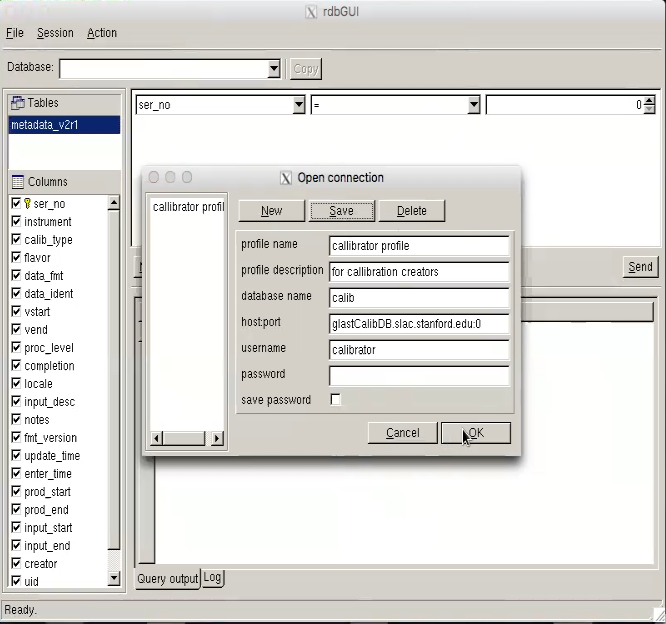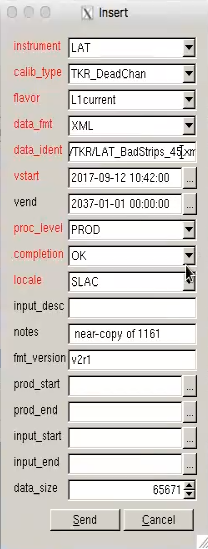Sometimes the instrument specialists give us new calibrations. Usually just a dead strip list for TKR, 3 (asym, MeV/DAC, peds) at a time for CAL. They need to be put in a standard place, registered in the calibration DB, and set active. This requires picking a time when validity switches from the previous set to the new one. We want this to happen between runs. The gaps between non-SAA runs are short, and CALDB doesn't do leap seconds, so I put the transitions near the middle of an SAA passage - the first one after the last run that we have data for.
Step-by-step guide
- Make sure your environment is setup correctly:
- Log into a SLAC machine. You will need to have X11 forwarding enabled (the -X or -Y option if not enabled by default).
- If one is not already sourced in your .bashrc or .cshrc then:
- bash: source /afs/slac.stanford.edu/g/glast/ground/scripts/group.sh
- (t)csh: source /afs/slac.stanford.edu/g/glast/ground/scripts/group.cshrc
- This will set environment variables like $GLASTROOT and the path to the GUI you will use below.
- Make sure that you have write permissions to the $LATCalibRoot directory.
- If not, ask Tom Glanzman
.
- If not, ask Tom Glanzman
- Log into a SLAC machine. You will need to have X11 forwarding enabled (the -X or -Y option if not enabled by default).
- Copy files to the "normal" place (if the instrument people haven't already):
- TKR: $LATCalibRoot/TKR
- CAL: $LATCalibRoot/CAL/p7repro
- Figure out the transition time:
- Go to the data processing page.
- Find the most recent run. It will be at the top, unless deliveries have arrived out of order.
- Click on the run number.
- Note the start time.
- Go to the mission planning timeline
- Find the first SAA passage that is still in the future processing wise.
- Pick a time that is in the middle of the SAA passage. That is when we will start the new calibration.
- You may also want to note the start time of the next run after the SAA. You will want to send that information to the data monitors list (see below) when you inform them of the new calibration.
- Go to the data processing page.
- Start the
rdbGUI. - Go to the "File" menu and select "Open DB Schema".
- Navigate to the directory
/afs/slac/g/glast/applications/dbSchemas/calib- You can paste this into the
File Namebox. - You can bookmark this location for future sessions by clicking on the flag icon.
- You can paste this into the
- Open the calib.xml file and click on
metadata_v2r1under the Tables box. - Under the
Sessionmenu, click on "Open connection". This will open a pop up box. - Fill in the box like the image below. The "profile name" and "profile description" boxes can be anything. The password is the same as the user name but with an "8" in place of the second "a". If you click "Save", then the connection information will be stored as a profile that you can load next time from the box on the left instead of typing everything in.
- Click "OK".
- Once connected, click on the drop down where is says "ser_no" (serial number) and set it to "instrument". It will fill in "LAT" in the box on the right.
- Click on the "More" button at the bottom of the upper box. This will add another drop down menu row.
- Select "flavor".
- In the right hand box (that may say "vanilla"), type in "L1current". There is no menu choice for it.
- Click on the "More" button again.
- Select "calib_type" (calibration type).
- In the right hand box, select the type, e.g., 'TKR_DeadChan'.
- If you don't know the type that corresponds to the file you have, you can pick an option from the menu and hit "Send" to see what the current/previous calibration files are used for that type.
For easier reference, here's a table with some example files and the calib_type for them.
file name example calib_type fit_gcrhists_lkhd_568m_572m_bigsum.gcr_asym_hist.xml CAL_Asym fit_proton_calib_568m_572m_bigsum.calMPD.xml CAL_MevPerDac pedavr_568m_572m.xml CAL_Ped
LAT_BadStrips_45.xml TKR_DeadChan
- Then click "Send".
- You will get something that looks like this:
- Add the new calibration file.
- Select the last row in the bottom box.
- Right-click and select "Copy Latest" from the menu.
- In the pop-up box that comes up, change the "vstart" time to the middle of the SAA passage chosen earlier.
- Change "data_ident" field to the file name for the XML file.
- Click "Send" and the pop-up will disappear.
- Click the "Send" button on the right hand middle of the box.
- There should be a new last line. Scroll over and check that the "vstart" time is correct and that the "vend" field of the previous line is the same.
- Do this for each of the calibration files that need to be updated. You are basically done.
- Send an email to whoever created the calibration files and cc the data monitor list (datamonlist@glast2.stanford.edu) to let them know when the calibration should take effect.
- Get the ID of the next run by using XTime or similar tool to convert start time of the next run after the SAA pass into MET.
- Include the start time and first run in the email, e.g., "vstart is 2018-09-28 03:43. First run should be 559799706."
- Later check that the new calibration has been used.
- Go to data processing page and click on the L1Proc bar for the run after the change should have happened.
- Go to the "Substreams" table in the middle of the page and click on one of the streams for the "doChunk" task.
- Go down to the "Substreams" table and click on any one of the "doCrumb" streams.
- Click on the log file link for the "recon" process.
- Search in the log for appropriate XML file(s).
Overview
Content Tools



